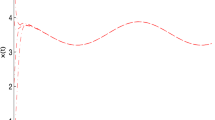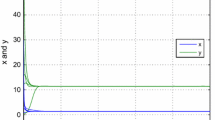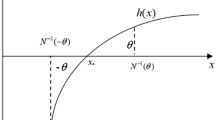Abstract
A global analysis of a Holling type II predator–prey model with a constant prey refuge is presented. Although this model has been much studied, the threshold condition for the global stability of the unique interior equilibrium and the uniqueness of its limit cycle have not been obtained to date, so far as we are aware. Here we provide a global qualitative analysis to determine the global dynamics of the model. In particular, a combination of the Bendixson–Dulac theorem and the Lyapunov function method was employed to judge the global stability of the equilibrium. The uniqueness theorem of a limit cycle for the Lineard system was used to show the existence and uniqueness of the limit cycle of the model. Further, the effects of prey refuges and parameter space on the threshold condition are discussed in the light of sensitivity analyses. Additional interesting topics based on the discontinuous (or Filippov) Gause predator–prey model are addressed in the discussion.


Similar content being viewed by others
References
Bernardo, M.D., Budd, C.J., Champneys, A.R., Kowalczyk, P., Nordmark, A.B., Tost, G.O., Piiroinen, P.T.: Bifurcations in nonsmooth dynamical systems. SIAM Rev. 50, 629–701 (2008)
Blower, S.M., Dowlatabadi, H.: Sensitivity and uncertainty analysis of complex-models of disease transmission? An HIV model, as an example. Int. Stat. Rev. 62, 229–243 (1994)
Brogliato, B.: Nonsmooth Mechanics. Springer, New York (1999)
Chen, L., Chen, F., Chen, L.: Qualitative analysis of a predator–prey model with Holling type II functional response incorporating a constant prey refuge. Nonlinear Anal., Real World Appl. 11, 246–252 (2010)
Chen, L.S., Jing, Z.J.: The existence and uniqueness of limit cycle of predator–prey differential equations. Chin. Sci. Bull. 9, 521–523 (1984)
Cheng, K.S.: Uniqueness of a limit cycle for a predator–prey system. SIAM J. Math. Anal. 12, 541–548 (1981)
Costa, M.I.S.: Harvesting induced fluctuations: Insights from a threshold management policy. Math. Biosci. 205, 77–82 (2007)
Costa, M.I.S., Meza, M.E.M.: Application of a threshold policy in the management of multispecies fisheries and predator culling. IMA Math. Med. Biol. 23, 63–75 (2006)
Costa, M.I.S., Kaszkurewicz, E., Bhaya, A., Hsu, L.: Achieving global convergence to an equilibrium population in predator–prey systems by the use of a discontinuous harvesting policy. Ecol. Model. 128, 89–99 (2000)
Dercole, F., Gragnani, A., Rinaldi, S.: Bifurcation analysis of piecewise smooth ecological models. Theor. Popul. Biol. 72, 197–213 (2007)
Eduardo, G.O., Rodrigo, R.J.: Dynamic consequences of prey refuges in a simple model system: more prey, fewer predators and enhanced stability. Ecol. Model. 166, 135–146 (2003)
Ermentrout, B.: Simulating, Analyzing, and Animating Dynamical Systems: A Guide to XPPAUT for Researchers and Students. SIAM, Philadelphia (2002)
Filippov, A.F.: Differential Equations with Discontinuous Righthand Sides. Kluwer Academic, Dordrecht (1988)
Gause, G.F., Smaragdova, N.P., Witt, A.A.: Further studies of interaction between predators and prey. J. Anim. Ecol. 5, 1–18 (1936)
Huang, X.C., Merrill, S.J.: Conditions for uniqueness of limit cycles in general predator–prey systems. Math. Biosci. 96, 47–60 (1989)
Ko, W., Ryu, K.: Qualitative analysis of a predator-prey model with Holling type II functional response incorporating a prey refuge. J. Differ. Equ. 231, 534–550 (2006)
Křivan, V.B.: On the Gause predator–prey model with a refuge: a fresh look at the history. J. Theor. Biol. 274, 67–73 (2011)
Křivan, V.: Behavioral refuges and predator–prey coexistence. J. Theor. Biol. (2013). doi:10.1016/j.jtbi.2012.12.016i
Kuang, Y., Freedman, H.I.: Uniqueness of limit cycles in Gause-type predator–prey systems. Math. Biosci. 88, 67–84 (1988)
Kuang, Y.: Global stability of Gause-type predator–prey systems. J. Math. Biol. 28, 463–474 (1990)
Kuznetsov, Y.A., Rinaldi, S., Gragnani, A.: One parameter bifurcations in planar Filippov systems. Int. J. Bifurc. Chaos 13, 2157–2188 (2003)
Ma, Z.H., Li, W.L., Zhao, Y.: Effects of prey refuges on a predator–prey model with a class of functional responses: the role of refuges. Math. Biosci. 218, 73–79 (2009)
May, R.M.: Limit cycles in predator prey communities. Science 177, 900–902 (1972)
Maynard Smith, J.: Models in Ecology. Cambridge University Press, Cambridge (1974)
Marino, S., Ian, B., Hogue, I.B., Ray, C.J., Kirschner, D.E.: A methodology for performing global uncertainty and sensitivity analysis in systems biology. J. Theor. Biol. 254, 178–196 (2008)
McNair, J.N.: Stability effects of prey refuges with entry-exit dynamics. J. Theor. Biol. 125, 449–464 (1987)
McNair, J.N.: The effects of refuges on predator–prey interactions: a reconsideration. Theor. Popul. Biol. 29, 38–63 (1986)
Meza, M.E.M., Bhaya, A., Kaszkurewicz, E.: Threshold policies control for predator–prey systems using a control Liapunov function approach. Theor. Popul. Biol. 67, 273–284 (2005)
Sih, A.: Prey refuges and predator–prey stability. Theor. Popul. Biol. 31, 1–12 (1987)
Tang, S.Y., Liang, J.H., Xiao, Y.N., Cheke, R.A.: Sliding bifurcations of Filippov two stage pest control models with economic thresholds. SIAM J. Appl. Math. 72, 1061–1080 (2012)
Tang, S.Y., Liang, J.H.: Global qualitative analysis of a non-smooth Gause predator-prey model with a refuge. Nonlinear Anal. TMA 76, 165–180 (2013)
Utkin, V.I., Guldner, J., Shi, J.X.: Sliding Mode Control in Electro-Mechanical Systems, 2nd edn. Taylor & Francis, London (2009)
Van de Vrande, B.L., Van Campen, D.H., De Kraker, A.: An approximate analysis of dry friction-induced stick-slip vibration by a smoothing procedure. Nonlinear Dyn. 19, 157–169 (1999)
Wang, Y., Wang, J.Z.: Influence of prey refuge on predator–prey dynamics. Nonlinear Dyn. 67, 191–201 (2012)
Xu, C.J., Shao, Y.F.: Bifurcations in a predator–prey model with discrete and distributed time delay. Nonlinear Dyn. 67, 2207–2223 (2012)
Zhang, Z.F., Ding, T.R., Huang, W.Z., Dong, Z.X.: Qualitative Theory of Differential Equations. American Mathematical Society, Providence (2006)
Acknowledgements
This work is supported by the National Natural Science Foundation of China (NSFC, 11171199) and by the Fundamental Research Funds for the Central Universities (GK201305010).
Author information
Authors and Affiliations
Corresponding author
Appendix
Appendix
Latin Hypercube Sampling/Partial Rank Correlation Coefficient (LHS/PRCC) sensitivity analysis is an efficient tool often employed in uncertainty analysis to explore the entire parameter space of a model with a minimum number of computer simulations. It involves the combination of two statistical techniques, Latin Hypercube Sampling (LHS) and Partial Rank Correlation Coefficient (PRCC) analysis. The goal of LHS/PRCC sensitivity analysis is to identify key parameters whose uncertainties contribute to prediction imprecision and to rank these parameters by their importance in contributing to this imprecision.
The LHS procedure is implemented by dividing the range of values for a given parameter into equally probable intervals, and the sampling is performed independently for each parameter. LHS can result in an unbiased estimate of the average model output, with the advantage that it requires fewer samples than simple random sampling to achieve the same accuracy. PRCC is a robust sensitivity measure for nonlinear but monotonic relationships between inputs and output, which is considered to be more powerful at determining the sensitivity of a parameter.
Rights and permissions
About this article
Cite this article
Tang, G., Tang, S. & Cheke, R.A. Global analysis of a Holling type II predator–prey model with a constant prey refuge. Nonlinear Dyn 76, 635–647 (2014). https://doi.org/10.1007/s11071-013-1157-4
Received:
Accepted:
Published:
Issue Date:
DOI: https://doi.org/10.1007/s11071-013-1157-4




